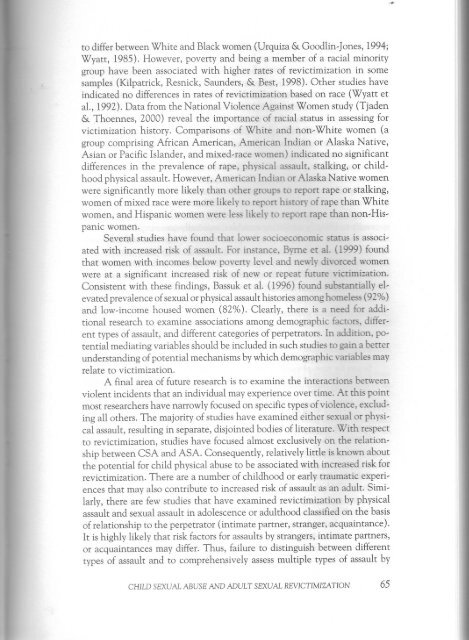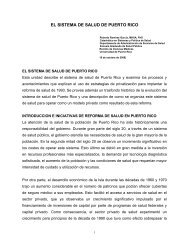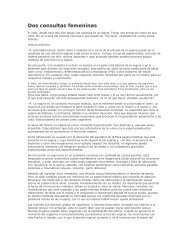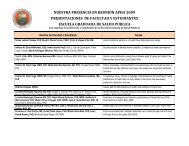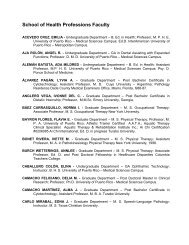CHILD SEXUAL ABUSE AND ADULT SEXUAL REVICTIMIZATION
CHILD SEXUAL ABUSE AND ADULT SEXUAL REVICTIMIZATION
CHILD SEXUAL ABUSE AND ADULT SEXUAL REVICTIMIZATION
Create successful ePaper yourself
Turn your PDF publications into a flip-book with our unique Google optimized e-Paper software.
to differbetween White and Blackwomen (Urquiza & Goodlin~Jones,1994;<br />
Wyatt, 1985). However, poverty and being a member of a racial minority<br />
group have been associated with higher rates of revictimization in some<br />
samples (Kilpatrick, Resnick, Saunders, & Best, 1998). Other studies have<br />
indicated no differences in rates of revictimization based on race (Wyatt et<br />
al., 1992). Data from the National Violence Against Women study (Tjaden<br />
& Thoennes, 2000) reveal the importance of racial status in assessingfor<br />
victimization history. Comparisons of White and non~White women (a<br />
group comprising African American, American Indian or Alaska Native,<br />
Asian or Pacific Islander, and mixed~racewomen) indicated no significant<br />
differences in the prevalence of rape, physical assault, stalking, or child~<br />
hood physical assault. However, American Indian or Alaska Native women<br />
were significantly more likely than other groups to report rape or stalking,<br />
women of mixed race were more likely to report history of rape than White<br />
women, and Hispanic women were less likely to report rape than non~His~<br />
panic women.<br />
Several studies have found that lower socioeconomic status is associ~<br />
ated with increased risk of assault. For instance, Byrne et aI. (1999) found<br />
that women with incomes below poverty level and newly divorced women<br />
were at a significant increased risk of new or repeat future victimization.<br />
Consistent with these findings, Bassuket al. (1996) found substantially el~<br />
evated prevalenceof sexualor physicalassaulthistoriesamonghomeless(92%)<br />
and low~incomehoused women (82%). Clearly, there is a need for addi~<br />
tional research to examine associations among demographic factors, differ~<br />
ent types of assault, and different categories of perpetrators. In addition, po~<br />
tential mediating variables should be included in such studies to gain a better<br />
understanding of potential mechanisms by which demographic variablesmay<br />
relate to victimization.<br />
A final area of future research is to examine the interactions between<br />
violent incidents that an individual may experience over time. At this point<br />
most researchers have narrowly focusedon specifictypes of violence, exclud~<br />
ing all others. The majority of studies have examined either sexual or physi~<br />
cal assault, resulting in separate, disjointed bodies of literature. With respect<br />
to revictimization, studies have focused almost exclusively on the relation~<br />
ship between CSA and ASA. Consequently, relatively little isknown about<br />
the potential for child physical abuse to be associated with increased risk for<br />
revictimization. There are a number of childhood or early traumatic experi~<br />
ences that may also contribute to increased risk of assault as an adult. Simi~<br />
larly, there are few studies that have examined revictimization by physical<br />
assault and sexual assault in adolescence or adulthood classifiedon the basis<br />
of relationship to the perpetrator (intimate partner, stranger, acquaintance).<br />
It is highly likely that risk factors for assaultsby strangers, intimate partners,<br />
or acquaintances may differ. Thus, failure to distinguish between different<br />
types of assault and to comprehensively assess multiple types of assault by<br />
<strong>CHILD</strong> <strong>SEXUAL</strong> <strong>ABUSE</strong> <strong>AND</strong> <strong>ADULT</strong> <strong>SEXUAL</strong> <strong>REVICTIMIZATION</strong><br />
65


